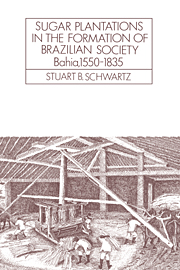Book contents
- Frontmatter
- Contents
- List of figures, maps, and tables
- Preface
- Abbreviations and special terms
- Weights and measures
- Dedication
- Part I Formations, 1500–1600
- Part II The Bahian engenhos and their world
- 4 The Recôncavo
- 5 Safra: the ways of sugar making
- 6 Workers in the cane, workers at the mill
- 7 The Bahian sugar trade to 1750
- 8 A noble business: profits and costs
- Part III Sugar society
- Part IV Reorientation and persistence, 1750–1835
- Appendixes
- Notes
- Glossary
- Sources and selected bibliography
- Sources of figures
- Index
- CAMBRIDGE LATIN AMERICAN STUDIES IN PRINT
6 - Workers in the cane, workers at the mill
Published online by Cambridge University Press: 05 May 2010
- Frontmatter
- Contents
- List of figures, maps, and tables
- Preface
- Abbreviations and special terms
- Weights and measures
- Dedication
- Part I Formations, 1500–1600
- Part II The Bahian engenhos and their world
- 4 The Recôncavo
- 5 Safra: the ways of sugar making
- 6 Workers in the cane, workers at the mill
- 7 The Bahian sugar trade to 1750
- 8 A noble business: profits and costs
- Part III Sugar society
- Part IV Reorientation and persistence, 1750–1835
- Appendixes
- Notes
- Glossary
- Sources and selected bibliography
- Sources of figures
- Index
- CAMBRIDGE LATIN AMERICAN STUDIES IN PRINT
Summary
… peoples the color of the very night working intensely and moaning together without a moment of peace or rest; who sees all the confused and tumultuous machinery and apparatus of that Babylon can not doubt though they may have seen Vesuvius or Mount Etna that this is the same as Hell.
Padre Antônio Vieira (1633)The crucial element in the manufacture of sugar was the slaves. The conditions under which they lived and worked are a key to the nature of the society that grew from the sugar economy. The relationships of slaves to engenhos and of slaves to the means and process of production are foci of concern. A great deal has been written about the physical condition of slaves in Brazil, although much of it is contradictory. This chaper will briefly outline these physical conditions, but the fundamental topic here will be the work of sugar making, its nature and requirements, for this above all determined the life of the men and women who labored in field and mill.
In the seventeenth century, many planters seem to have subscribed to the three-p theory of slave management mentioned by Antonil: pau (the rod), pāo (bread), and pano (clothing). Foreign observers such as Johan Nieuhoff, who visited Brazil in that century, invariably spoke of the brutality of the slave regime and noted that Brazilian slaves were poorly fed, housed, and clothed.
- Type
- Chapter
- Information
- Sugar Plantations in the Formation of Brazilian SocietyBahia, 1550–1835, pp. 132 - 159Publisher: Cambridge University PressPrint publication year: 1986



